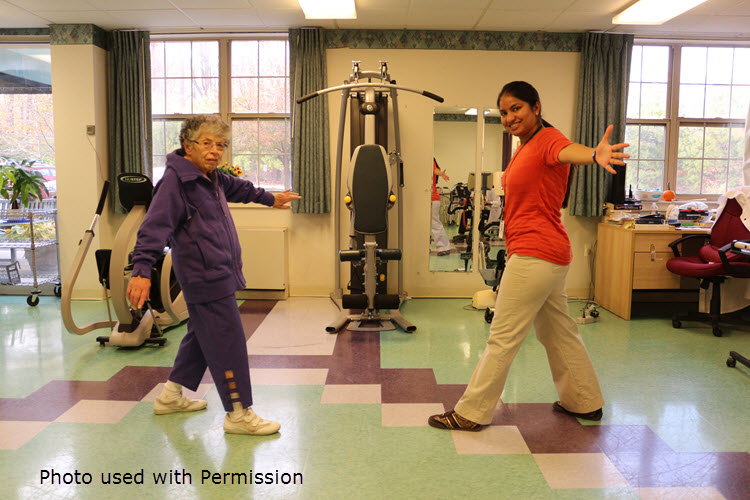Adapts for Patient Fatigue.
Controlling Parkinson’s Disease (PD) symptoms is primarily achieved with medication timing and rehabilitation therapy. The link between these two treatments is undeniable. Once dopamine replacement medication has been given, there is a short window when the PD patient has optimal energy and will get the most physical and emotional benefit from rehab. Finding a rehabilitation program that can be tolerated by a PD patient, and that understands and works with medication timing is critical. (Jump to Lessons Learned)
Many Parkinson’s sufferers cannot tolerate the three hours a day, five days a week rehabilitation requirement of an acute rehab facility as laid out by the Centers for Medicare & Medicaid Services (CMS). Fatigue is the issue, so the specialized rehabilitation program “Big and Loud” can be a better fit. It has a manageable pace, works to improve mobility, balance, endurance, and strength, and has a higher success rate for the Parkinson’s Patient.
What is “Big and Loud?”
“Big and Loud,” called LSVT, started in the 1980’s with a speech therapy program developed by Lee Silverman of Voice Treatment Gobal. Later, the same concepts were applied to limb movements calling it “Big”.
The “Big” rehabilitation program:
LSVT BIG is an exercise program that uses standardized exercises in conjunction with prescribed medication dosage. Big movements practiced in rehab are very exaggerated to compensate for deficiencies in perception. The patient participates in “BIG” rehabilitation during sixteen, one-hour individual sessions, held over four consecutive days in a week. This schedule requires a high level of effort on the patient’s part, includes daily homework practice and daily carryover exercises done every day, all year. The two pillars of BIG are intensity and medication dosing. Intensity is the key to motor learning and neuroplasticity. And medication dosage is frequent, timed, and dosed specifically for a patient and their rehabilitation schedule.
Physical Therapy LSVT certification for BIG
Re-educates the sensorimotor system with an intensive amplitude-based exercise program for the limb motor system. These exercises are Parkinson’s disease specific based on neuroplasticity and research.
Occupational Therapy SVT certification for BIG
Activities of Daily Living can be frustrating for Parkinson’s patients. Rigidity and loss of mobility can make it difficult to use a fork or spoon. Staff and family need to recognize this and look for alternatives like finger foods to minimize frustration. Swallowing can become an issue as the disease progresses, as can excessive saliva.
The “Loud” Rehabilitation program:
The speech of Parkinson’s disease patients suffer; words are not clear and their voice is soft. The “Loud” speech therapy teaches patients techniques to strengthen the volume and clarity of speech.
Speech Therapy LSVT certification for LOUD
Uses an intensive amplitude-based exercise program for the speech motor system.
The Princeton Care Center (PCC) in Princeton, New Jersey is one of a few Big and Loud rehabilitation programs in the state. PCC offers rehabilitation and treatment programs equivalent to other programs for non-PD patients. But Parkinson’s Disease patients find that the PCC Big and Loud program provides a truly effective treatment system. Princeton Care Center physical, occupational, and speech therapists are part of an elite group of 15,000 therapists in 54 countries specially trained to provide this rehabilitation. PCC therapists offer the Big and Loud modalities in an inpatient sub-acute setting and adapts it for the individual. Length of a Big and Loud program varies from a couple of weeks to up to three months, and the length is based on the patient’s ability to tolerate the rehab regime.
- For each facility you are considering, understand how medication is timed to work with the scheduled rehabilitation. For example, let’s say the medication (Sinimet) is scheduled to be given at 7:00 am, and it will take about 45 minutes for the drug to work at its optimal level. By 7:30 – 8:45 the patient has the energy for rehab. If rehab is scheduled for 10:30 or 11:00 the max benefit of the drug is gone. Now rehab is frustrating, and anxiety producing. The patient may get depressed since they can no longer accomplish tasks they could have accomplished two hours before.
- Research the staff to ensure they undergo training that allows them to:
- Read and understand a patient’s movements and facial rigidity
- Effectively manage the medication and appointment schedule to optimize energy levels
- Recognize Dis-kinetic motions that can indicate too much medicine
- Are on top of secondary symptoms such as excessive saliva
- Upon completing rehabilitation, the patient needs to continue daily exercises at home under the supervision of a caregiver, or at an outpatient facility. Statistics gathered by national organizations prove that when the patient maintains the rehab exercises at home, and there is now new major trauma that compromises their health, the benefits of Big and Loud can last up to two years.
Thank you to my collaborator on this series, John Devone.
John Devone obtained his MD degree from the University of Bologna, where he also did a doctoral thesis in geriatric rehabilitation as well as working in research at the University. Prior to joining Princeton Care Center (PCC) as VP of operations, John worked in administration at the NYC Rusk Institute of Rehabilitation. John’s mom has been a Parkinson’s Disease patient for over 20 years, and has benefited from the Big and Loud rehabilitation program as PCC. Thank you to John and his mother for allowing us to use photos of her participating in Big and Loud. For more information on this program, click here: Princeton Care Center Parkinson’s Rehab
Disclaimer: The material in this blog is for educational purposes only. It is not intended to replace, nor does it replace, consulting with a physician, lawyer, accountant, financial planner or other qualified professional.

